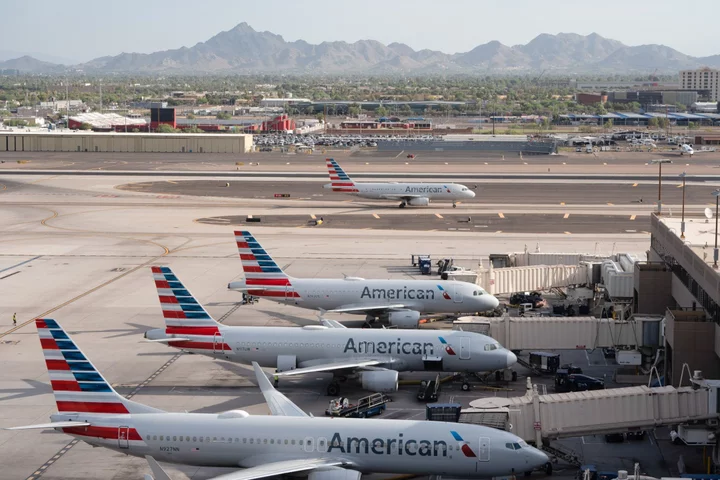The summer travel season got a rocky start in late June when thunderstorms, coupled with airport staff shortages across the US, caused as many as 7,700 flight delays and 2,200 cancellations in a single day.
But a lightning strike isn’t the most likely way travel plans get snarled. Passengers are learning the hard way this summer that high temperatures can be as disruptive to on-time departures as visibly inclement weather.
This week extreme heat has rippled across much of the US and Europe. Cities experiencing record-breaking temperatures have included Miami; Tampa; Portland, Oregon; San Antonio; and New Orleans. In Phoenix, July 12 marked the area’s 12th consecutive day of temperatures reaching over 110 degrees. The heat wave is said to have affected a quarter of the American population.
Federal Aviation Administration data show that for many airports summer weather is responsible for far more delays that winter weather—partially because it takes a less extreme weather event to send operations into a tailspin. Chicago O’Hare, for instance, had almost twice as many weather delays from June to August 2022 as it did from January to March 2023. At New York’s LaGuardia, there were 35% more weather delays in summer 2022 than the following winter.
Additional data from aviation analytics firm FlightAware shows that from January to March 2023 there were 402,881 flight delays in the US—representing 19.6% of all scheduled departures—whereas in the summer months of June to August 2022, there were 544,462 delays, or 23.3% of the country’s flights.
Winter storms can cause more widespread havoc, however. Of a dozen events that caused mass disruptions to US flights in the last 12 or so years, 8 stemmed from winter storms; only 3 related to hurricanes. (The 12th was Covid-19.) Heat waves may not result in large-scale breakdowns in service but are instead a constantly humming engine of daily disruption in which season-long impacts can add up.
“When temperatures exceed 39 degrees centigrade [102F], it becomes really problematic for airlines,” says Bijan Vasigh, professor of economics and finance at Embry-Riddle Aeronautical University in Daytona Beach, Florida.
Heat thins the air, which reduces the lift that helps planes take off. The hotter the temperature, the more power is required to get airborne.
“The hotter and more humid the surrounding air is, the more aircraft engine and airfoil performance degrade,” echoes Kathleen Bangs, a former commercial pilot who’s now a spokesperson for FlightAware. “Aircraft get their best performance during cool or cold temperatures as the density of the air increases.”
In hot weather, pilots may decide to delay flights or reduce the weight aboard the aircraft by dumping excess fuel, bumping bags or even taking off some passengers; ultimately, in a game of wait-and-see, they can run into such issues as running out of fuel or exceeding time limits on staff shifts. For passengers, that can mean flight disruptions, route changes or delayed luggage.
The logic around where heat can ground flights is counterintuitive and doesn’t always correlate to where temperatures are hottest. See famously snowy Denver: The Mile High City has more delays in summer than winter, when comparing only those disruptions that are attributed specifically to weather.
“Elevation also has an effect,” Bangs explains. “Taking off at higher-altitude airports during extreme heat can have [additional] limitations on weight.”
There are ways to avoid these disruptions, even without knowing what’s in the forecast. For one thing, the airport you choose can make a difference. “Older or smaller airports, such as London City for instance, have shorter runways,” says Vasigh, adding that longer runways allow pilots to accelerate with more power and offset the effects of hot, thin air. This, he says, is why an airline like Emirates can operate seamlessly in Dubai, where average high temperatures climb to 106F during the peak summer months. It’s also why Chicago’s O’Hare suffers from a greater proportion of summer disruptions than winter ones, despite the Midwest’s relatively mild summer weather and brutal winter storms.
Vasigh adds that flights departing between 11 a.m. and 2 p.m. are the most likely to be affected, given midday heat and a lack of shade on tarmacs and runways. Booking in the early-morning hours is a smart way to avoid flight delays, generally speaking, but it also helps mitigate this particular cause.
And avoid checking luggage. When the temperature starts climbing rapidly, airlines can reduce their maximum weight allowance for safe takeoff. Since luggage is the last thing loaded onto a plane after passengers board, operations crews can more easily control for weight by reducing the number of checked bags they allow into the cargo hold.

